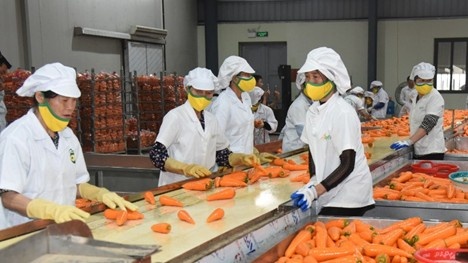Vietnam’s fruits and vegetables accelerate toward the USD 10 billion export milestone.
Vietnam’s fruit and vegetable industry is making a strong breakthrough, with export turnover in the first ten months of 2025 exceeding USD 7 billion, up 14% compared to the same period in 2024. This impressive growth is driven not only by key products such as durian, mango, and pomelo, but also by the industry’s quick adaptation to the strict requirements of high-end markets and its focus on standardizing raw material areas.

Momentum from Key Fruits and High-End Markets
According to the Vietnam Fruit and Vegetable Association (VinaFruit), the industry’s impressive growth in recent months has been driven by strategic fruit categories such as durian, banana, mango, jackfruit, coconut, and pomelo.
Mr. Đặng Phúc Nguyên, General Secretary of the Association, noted that from late Q2 to early Q3, fruit and vegetable exports surged strongly thanks to abundant supply and significant added value.
In particular, durian has emerged as the “star” of the year, with export value projected to exceed USD 3 billion, making a substantial contribution to overall growth.
Beyond the Chinese market, Vietnamese fruits are affirming their presence in the United States, Canada, Japan, and most recently Australia, where Vietnamese pomelo has just been approved for import.
This milestone highlights Vietnam’s capacity to meet stringent food safety and traceability standards.
According to Mr. Nguyên, the successful opening of the Australian market serves as a springboard for Vietnam to expand into other demanding markets.
He expects the Plant Protection Department (Ministry of Agriculture and Rural Development) to soon complete procedures for pomelo exports to China — a massive market importing USD 17–18 billion worth of fruits and vegetables annually, of which Vietnam currently accounts for only USD 4–5 billion.
With its geographic proximity, low logistics costs, and stable supply capacity, Vietnam has significant room to increase market share. However, to sustain growth, the industry must ensure food safety, strict quarantine compliance, and clear traceability — all crucial factors in competing in high-end markets.
Adapting to New Policies and Standardizing Production Areas
A key strategic direction now is the development of standardized raw material zones.
The pilot project on developing agricultural and forestry raw material areas for domestic consumption and export (2022–2025) has been recognized as a timely and effective initiative, helping Vietnamese produce achieve uniform quality, traceability, and compliance with VietGAP and GlobalGAP standards.
Nevertheless, fragmented and small-scale production remains a major challenge.
Infrastructure, irrigation systems, and farmer–business linkages are still limited, while understanding of quarantine regulations across markets remains inconsistent.
In this context, China’s Decree No. 280, which will take effect on June 1, 2026, replacing Decree No. 248, is expected to mark a turning point for Vietnamese agricultural exports.

According to Mr. Ngô Xuân Nam, Deputy Director of the Vietnam SPS Office, China’s Decree No. 280 marks a shift from an administrative management model to a risk-based management approach, allowing for more flexible control and better alignment with international practices.
He emphasized that Vietnamese enterprises should review and update their registration codes on the CIFER system, maintain HACCP and ISO 22000 certifications for processed goods, and strictly comply with planting area codes and packing facility codes for fresh fruits.
A positive point is that the new regulation allows automatic renewal of registration codes for five years if no violations occur — significantly reducing administrative procedures. If Vietnam maintains a transparent and reliable control system, its enterprises will be classified as low-risk and enjoy export priority.
With steady growth momentum, proactive adaptation to new regulations, and a strategic focus on standardizing raw material zones, Vietnam’s fruit and vegetable industry stands before a golden opportunity to reach the USD 10 billion export milestone. This success would not only affirm the competitiveness of Vietnamese produce, but also highlight the industry’s strategic vision toward quality, transparency, and sustainable development in the global market.






